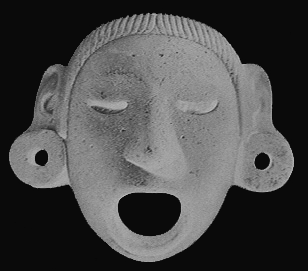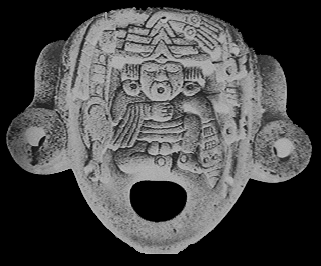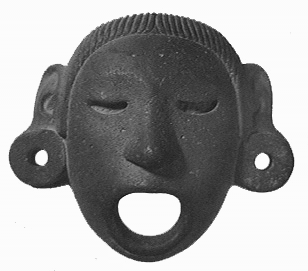
Aztec Sculpture


|


The sculptures range from the miniature to the monumental in scale. The sculptors worked both in low relief and in the round, and often the two styles are inseperable, as statues commonly included scenes or symbols carved in relief.(Baquedano 1984:25)

Sculptures of the Gods were an important aspect of Aztec religious expression. Statues were placed before altars - essential features of every Aztec household - and were made to adorn shrines and temples or to be set up in the open air. Thus the people were constantly aware of the forces which governed the universe and their lives.
(Baquedano 1984:25)

|
(Baquedano 1984:36)
Due to the loss and deterioration of much Aztec Art, sculpture is not only the most durable and possibly impressive, but also the most important. It is through scuplture, and the portrayal of the gods that we gain a better understanding of Aztec religion.

|
(Baquedano 1984:37)

The Aztecs had not only their own gods, but gods they had adopted as a result of the capture of other cities.
Every god and it's sculpture were instantly recognisable. Particular dress, regalia and colours typified each god, and often groups of gods. For example, while the gods of water and vegetation all wore similiar head-dresses, the colours would differ.
Following is only a collection of some of the Aztec Gods and Goddesses. They have been chosen for their representation in sculpture, importance to Aztec religion and also to aid an understanding of their history and myths.
| Quetzalcoatl | Ehecatl | Tlaloc | Chalchiuhtlicue |
| Coatlicue | Huitzilopochtli | Xipe Totec |
Coyolxauhqui
|

QUETZALLI meaning feathers and precious, and COATL meaning serpent or twin.

|
Quetzalcoatl head, Teotihuacan. (http://www.lonelyplanet.com.au/dest/cam/graphics/mex21.htm)
Images of Quetzalcoatl abound in Mesoamerica from the beginning of the Olmec period (around 1200 b.c.) to the arrival of the Spanish.
The name Quetzalcoatl means 'precious twin', but also 'feathered or plumed serpent', which is the form in which he is most often and most importantly represented. He had many different associations; he was one of the four 'creator gods'; he was associated with birth and renewal, the breath of life, and, as such, in other forms and personality as Ehecatl, the wind god. He was the god of priests, goldsmiths, and other craftsmen,and learning and crafts, and also the god of twins. He is also associated with the planet venus, the discovery of corn and the invention of writing. Further, the Aztec rulers claimed to descend from the Toltec royal line, and thus, implicitely also from Quetzalcoatl.

|
"Quetzalcoatl ruled over the days that bore the name ehecatl ("wind") and over the second 13-day series of the ritual calendar. He was also the ninth of the 13 gods of the day-time hours. Although he was generally listed as one of the first-rank deities, no ceremonial month was dedicated to his cult."(http://www.spots.ab.ca/~atiera/aztec.htm) He is most often portrayed as emerging from the feathered serpent, and, as such, is symbolic of the rise of the morning star, and the symbiosis of heaven and earth.

|
"It is clear that in the story of Quetzalcoatl history and legend are closely intertwined. Legend has it that Quetzalcoatl, the god, had a rival called Tezcatlipoca, god of the night and of the north, who wanted to establish the cult of militarism and human sacrifice in opposition to the benevolent Quetzalcoatl, who had taught men the skills of medicine and astronomy, as well as arts and crafts, and who demanded from people only non-violent offerings of jade, snakes, and butterflies.Tezcatlipoca won the conquest and, as a result, Quetzalcoatl is said to have left Tula in 987. With his followers he crossed the valley of Mexico, passing between the volcanoes Iztaccihuatl and Popocatepetl, and continued to the Gulf of Mexico, where he set himself alight and was reborn as the Morning Star. A different historical source tells of how Quetzalcoatl and his followers setr out over the sea on a raft made of serpents. He journeyed towards the east, whence, he prophesised, he would one day return. It was this legend that Moctezuma II recalled and, it seems, believed, so that when Cortes landed in Mexico in 1519 Moctezuma thought him to be the returning Quetzalcoatl."
(Baquedano 1984:8)


|
Ehecatl may be distinguished by his beak-like mouth and conical hat.

the god of all water, from all sources,
or He Who Makes Things Sprout.

|
It is typical of an agrarian culture uncertain and dependant on rainfall and water with no irrigation system to place such importance on a god of this kind. As such Tlaloc was "not only highly revered, but he was also greatly feared. He could send out the rain or provoke drought and hunger. He hurled lightning upon the earth and unleashed the devastating hurricanes. The Tlaloque, it was believed, could send down to the earth different kinds of rain, beneficent or crop-destroying. Certain illnesses, such as dropsy, leprosy, and rheumatism, were said to be caused by Tlaloc and his fellow deities. Although the dead were generally cremated, those who had died from one of the special illnesses or who had drowned or who had been struck by lightning were buried. Tlaloc bestowed on them an eternal and blissful life in his paradise, Tlalocan.("http://www.spots.ab.ca/~atiera/aztec.htm)
The importance of this god to the Aztecs is represented by the sheer number of statues found. He was equal in rank to Huitzilopochtli and one of the most ancient in Mesoamerica dating back to the Teotihuacan Culture (third to eigth centuries b.c.). As such, on top of the Great Temple at Tenochtitlan were two sanctuaries of the same size; one was dedicated to Huitzilopochtli (the Aztec Sun and War God), and one was dedicated to Tlaloc.
According to the "divinatory calendars, Tlaloc was the eigth ruler of the days and the ninth lord of the nights. Five months of the 18-month ritual year were dedicated to Tlaloc and to his fellow deities, the Tlaloque, who were believed to dwell on th mountaintops. Children were sacrificed to Tlaloc on the first month, Atlcaualo, and on the third, Tozoztontli. During the sixth month, Etzalqualiztli, the rain priests ceremonially bathed in the lake; they imitated the cries of the waterfowls and used magic "fog bells" (ayauhchicauaztli) in order to obtain rain. The 13th month, Tepeilhuitl, was dedicated to the mountain Tlaloque; small idols made of amaranth paste were ritually killed and eaten. A similar rite was held on the 16th month, Atemoztli." (http://www.spots.ab.ca/~atiera/aztec.htm)
He is most often characterised by "coiled snakes which form a mask around his eyes and mouth and by his curved fangs. His characteristic attire consists of a pleated paper fan worn at the back of the head (amacalli, 'house of paper'), ear plugs and a head-dress set with precious stones which [often] represent water." (Baquedano 1984:)

Goddess of Fresh Water,
or She Who Wears a Jade Skirt.
 |
(Baquedano 1984:32)
As the Goddess of Fresh Water, Chalchiuhtlicue presided over rivers, lakes, streams, and other forms of freshwater. She was also the patron of fisherman and other who made their living from water. She was closely associated with Tlaloc, the God of all Water, and has been described alternately as his Wife, Sister, or Mother, and, like him, needed to be placated in order to assure the continual need for water.
The sculptures of Chalchiuhtlicue are characterised by a youthful visage and figure typically shown in the kneeling position, and a "head-dress consisting of three bands tied at the back of the head and fringed top and bottom with discs representing amaranth seeds (amaranth was an important constituent of the Mesoamerican diet, providing protein); a large tassel hangs down at each side of her face. [This is exemplified in the image below.]) She is also often shown wearing a paper fan , usually painted blue. Green jade ornaments are often shown decorating her skirt and symbolise water:[hence the name] 'Lady of the Jade Skirt'(chalchiuitl=jade or precious stone and cueitl=skirt). She is also called Lady Precious Green. "
 |
The importance of this Goddess is exemplified through this use jade and reference to it since jade was more precious than gold to the Aztecs.
Further, the sculptures of Chalchiuhtlicue are also indicative of the style of clothes and head-dress often worn by Aztec Women: a long wrap-around skirt and worn over a simple top and shoulder-cape called quechquemitl. The hairstyle is also representative of that which Aztec Women wore: loose everyday and braided for special occasions such as festivals. Further, these clothes and hairstyles are also indicative of social class within Aztec Society.

 |
Coatlicue traditionally "wears a skirt of intertwined serpents and a belt in a form of a snake [the Aztec symbol of fertility], Her breasts are always shown bare, symbolising her role as mother of the Gods. Her face is generally fleshless and her hands and feet are very often depicted with claws." (Baquedano 1984:19)
 |

 |
Huitzilopochtli was the Aztec Sun and War God. "Because the Aztecs believed that dead warriors were reincarnated as hummingbirds and because the south considered the left side of the world, Huitzilopochtli's name, therefore, meant the Resuscitated Warrior of the South. His other names included Xiuhpilli (Turquoise Prince) and Totec (Our Lord). His nagual, or animal disguise, was the eagle. Traditionally, Huitzilopochtli was thought to have been born on the Coatepec Mountain, near the city of Tula. His mother Coatlicue, an earth goddess, conceived him after having kept in her bosom a ball of hummingbird feathers (i.e. the soul of a warrior) that fell from the sky. His brothers, the Centzon Huitznaua (Four Hundred Southerners), stars of the southern sky, and his sister Coyolxauhqui, a night goddess decided to kill him, but he exterminated them with his weapon, the xiuhcoatl ("turquoise snake")."(http://www.spots.ab.ca/~atiera/aztec.htm)
As such, Huitzilopochtli is usually represented as a Hummingbird or as a Warrior with armour and helmet made from the feathers of hummingbirds.

Our Lord the Flayed One
 |
As well as being the God of Fertility, Spring and New Growth, Xipe Totec was one of the four creator gods. He is most often associated with death, suffering and sacrificial self-mutilation. He was most often shown wearing a flayed human skin, and his full face with open mouth and closed eyes represented death to the Aztecs. Further, the priests wore a flayed skin of human sacrifices in the same manner, symbolising the regeneration of plant life every spring. Masks such as the one shown here are very common and were possibly placed over the faces of the dead. These masks are still being made in Mexico today.
Xipe Totec was also the patron of Goldsmiths. This is possibly due to the fact that "Xipe Totec was originally a deity of the Zapotec and Yopi Indians in the present states of Oaxaca and Guerrero, an area believed to be particularly rich in gold."(http://www.spots.ab.ca/~atiera/aztec.htm)

Lady Golden Bells.
 |
Coyolxauhqui was the daughter of Coatlicue and the Goddess of the Moon and the Night. She and her brothers and sisters defeated Huitzilopochtli at his birth.

| Aztec Art and Religion | Aztec Sculpture | Crafts and The Markets |
|
| Title Page |
